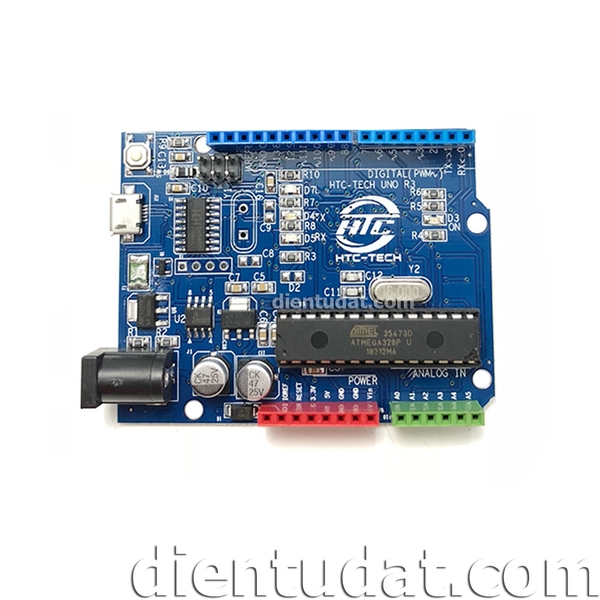

The ATmega328 provides UART TTL (5V) serial communication, which is available on digital pins 0 (RX) and 1 (TX). The Arduino Uno has a number of facilities for communicating with a computer, another Arduino, or other microcontrollers. Typically used to add a reset button to shields which block the one on the board. Bring this line LOW to reset the microcontroller. Reference voltage (0 to 5V only) for the analog inputs. There are a couple of other pins on the board: Support I2C (TWI) communication using the Wire library. Additionally, some pins have specialized functionality: By default they measure from ground to 5 volts, though is it possible to change the upper end of their range using the AREF pin and the analogReference() function. The Uno has 6 analog inputs, labeled A0 through A5, each of which provide 10 bits of resolution (i.e. When the pin is HIGH value, the LED is on, when the pin is LOW, it's off. There is a built-in LED connected to digital pin 13. These pins support SPI communication using the SPI library. Provide 8-bit PWM output with the analogWrite() function. These pins can be configured to trigger an interrupt on a low value, a rising or falling edge, or a change in value. These pins are connected to the corresponding pins of the ATmega8U2 USB-to-TTL Serial chip. Used to receive (RX) and transmit (TX) TTL serial data. In addition, some pins have specialized functions: Each pin can provide or receive a maximum of 40 mA and has an internal pull-up resistor (disconnected by default) of 20-50 kOhms. It also has 2 KB of SRAM and 1 KB of EEPROM (which can be read and written with the EEPROM library).Įach of the 14 digital pins on the Uno can be used as an input or output, using pinMode(), digitalWrite(), and digitalRead() functions. The ATmega328 has 32 KB (with 0.5 KB used for the bootloader). A 3.3 volt supply generated by the on-board regulator. This can come either from VIN via an on-board regulator, or be supplied by USB or another regulated 5V supply. The regulated power supply used to power the microcontroller and other components on the board. You can supply voltage through this pin, or, if supplying voltage via the power jack, access it through this pin. The input voltage to the Arduino board when it's using an external power source (as opposed to 5 volts from the USB connection or other regulated power source). If using more than 12V, the voltage regulator may overheat and damage the board. If supplied with less than 7V, however, the 5V pin may supply less than five volts and the board may be unstable. The board can operate on an external supply of 6 to 20 volts. Leads from a battery can be inserted in the Gnd and Vin pin headers of the POWER connector.

The adapter can be connected by plugging a 2.1mm center-positive plug into the board's power jack. The power source is selected automatically.Įxternal (non-USB) power can come either from an AC-to-DC adapter (wall-wart) or battery.

The Arduino Uno can be powered via the USB connection or with an external power supply. The second one is a not connected pin, that is reserved for future purposes.ģ2 KB (ATmega328) of which 0.5 KB used by bootloader In future, shields will be compatible both with the board that use the AVR, which operate with 5V and with the Arduino Due that operate with 3.3V. 1.0 pinout: added SDA and SCL pins that are near to the AREF pin and two other new pins placed near to the RESET pin, the IOREF that allow the shields to adapt to the voltage provided from the board.
#Arduino uno r3 plus series
The Uno is the latest in a series of USB Arduino boards. The Uno and version 1.0 will be the reference versions of Arduino, moving forward. "Uno" means one in Italian and is named to mark the upcoming release of Arduino 1.0. Instead, it features the Atmega8U2 programmed as a USB-to-serial converter.
#Arduino uno r3 plus driver
The Uno differs from all preceding boards in that it does not use the FTDI USB-to-serial driver chip. It contains everything needed to support the microcontroller simply connect it to a computer with a USB cable or power it with a AC-to-DC adapter or battery to get started. It has 14 digital input/output pins (of which 6 can be used as PWM outputs), 6 analog inputs, a 16 MHz crystal oscillator, a USB connection, a power jack, an ICSP header, and a reset button. The Arduino Uno is a microcontroller board based on the ATmega328. It contains everything needed to support the microcontroller simply connect it to a computer with a USB cable to get started. It has 14 digital input/output pins (of which 6 can be used as PWM outputs), 6 analog inputs, a 16 MHz ceramic resonator, a USB connection, a power jack, an ICSP header, and a reset button. The Arduino Uno Rev3 is a microcontroller board based on the ATmega328 ( datasheet).


 0 kommentar(er)
0 kommentar(er)
